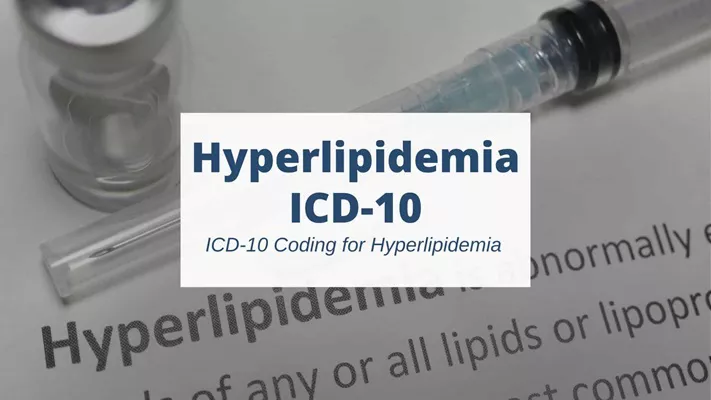Hyperlipidemia, a condition characterized by elevated levels of lipids in the blood, is a major risk factor for cardiovascular diseases, including heart attacks and strokes. It encompasses a variety of lipid abnormalities, including high levels of cholesterol, triglycerides, or both. Accurate diagnosis and coding of hyperlipidemia are essential for effective treatment and management, as well as for administrative and billing purposes in healthcare systems. The International Classification of Diseases, Tenth Revision (ICD-10) provides a comprehensive system for coding and classifying diseases and a wide variety of signs, symptoms, abnormal findings, and external causes of injury or diseases. This article delves into the ICD-10 codes related to hyperlipidemia, their importance, and how they are used in clinical practice.
ICD-10 Code Overview
The ICD-10 system, maintained by the World Health Organization (WHO), is a globally recognized diagnostic tool used by healthcare providers to classify and code all diagnoses, symptoms, and procedures recorded in conjunction with hospital care. It replaced the ICD-9 system in October 2015 in the United States and has since been adopted worldwide.
SEE ALSO: What Is Familial Combined Hyperlipidemia?
ICD-10 Codes for Hyperlipidemia
Hyperlipidemia is primarily coded under the ICD-10 code E78. The E78 code range is used for disorders of lipoprotein metabolism and other lipidemias. Here are the specific codes related to hyperlipidemia:
E78.0 Pure Hypercholesterolemia: This code is used for conditions characterized by elevated levels of cholesterol in the blood.
E78.1 Pure Hyperglyceridemia: This code is used for conditions where there is an abnormally high concentration of triglycerides in the blood.
E78.2 Mixed Hyperlipidemia: This code is used when both cholesterol and triglycerides levels are elevated.
E78.3 Hyperchylomicronemia: This code is used for elevated levels of chylomicrons, which are large lipoprotein particles that carry triglycerides in the blood.
E78.4 Other Hyperlipidemia: This code is used for other specified types of hyperlipidemia that do not fall into the above categories.
E78.5 Hyperlipidemia, Unspecified: This code is used when the specific type of hyperlipidemia is not identified or documented.
Clinical Significance of Accurate ICD-10 Coding
Accurate ICD-10 coding for hyperlipidemia is critical for several reasons:
Patient Management: Proper coding helps in the accurate identification of the type of hyperlipidemia, which is essential for tailoring appropriate treatment plans. Different types of hyperlipidemia may require different therapeutic approaches, including dietary changes, lifestyle modifications, and pharmacotherapy.
Insurance and Reimbursement: ICD-10 codes are used by insurance companies to determine reimbursement for medical services.
Accurate coding ensures that healthcare providers receive appropriate compensation for the services they provide.
Epidemiological Tracking: Accurate coding allows for the collection of data on the prevalence and incidence of hyperlipidemia, which is important for public health surveillance and research. This data helps in understanding trends, evaluating the effectiveness of interventions, and planning public health strategies.
Clinical Research: Proper documentation and coding of hyperlipidemia are essential for clinical research. It allows researchers to identify and categorize patient populations accurately, facilitating studies on the efficacy of treatments and the pathophysiology of lipid disorders.
Coding Scenarios And Examples
To illustrate the use of ICD-10 codes for hyperlipidemia, consider the following scenarios:
Case of Pure Hypercholesterolemia:
A 55-year-old male presents with high cholesterol levels discovered during a routine check-up. Laboratory tests confirm elevated LDL cholesterol levels without significant triglyceride elevation.
ICD-10 Code: E78.0 (Pure Hypercholesterolemia)
Case of Mixed Hyperlipidemia:
A 60-year-old female with a family history of cardiovascular disease presents with high cholesterol and triglyceride levels.
ICD-10 Code: E78.2 (Mixed Hyperlipidemia)
Case of Hyperlipidemia, Unspecified:
A 45-year-old male has elevated lipid levels, but the specific type of lipid abnormality is not documented in his medical records.
ICD-10 Code: E78.5 (Hyperlipidemia, Unspecified)
Management And Treatment of Hyperlipidemia
The management of hyperlipidemia involves lifestyle modifications and pharmacotherapy. Here’s a brief overview:
Lifestyle Modifications:
Diet: A heart-healthy diet low in saturated fats, trans fats, and cholesterol can help manage hyperlipidemia. Increasing intake of fruits, vegetables, whole grains, and omega-3 fatty acids is beneficial.
Exercise: Regular physical activity can help lower LDL cholesterol and raise HDL cholesterol levels. At least 30 minutes of moderate-intensity exercise on most days of the week is recommended.
Weight Management: Maintaining a healthy weight can help control lipid levels and reduce the risk of cardiovascular disease.
Avoiding Tobacco and Limiting Alcohol: Smoking cessation and limiting alcohol intake can have positive effects on lipid profiles.
Pharmacotherapy:
Statins: These are the most commonly prescribed medications for lowering LDL cholesterol.
Fibrates: These drugs primarily lower triglyceride levels and can also increase HDL cholesterol.
Niacin: This vitamin can help lower LDL cholesterol and triglycerides while raising HDL cholesterol.
Cholesterol Absorption Inhibitors: Ezetimibe is an example of a drug that reduces the absorption of cholesterol from the intestine.
PCSK9 Inhibitors: These are newer agents that can significantly lower LDL cholesterol levels, often used in patients with genetic forms of hyperlipidemia or those who cannot achieve their lipid goals with other therapies.
Conclusion
Hyperlipidemia is a common yet serious condition that requires accurate diagnosis and coding for effective management.
The ICD-10 coding system provides specific codes for different types of hyperlipidemia, which are essential for patient care, insurance reimbursement, epidemiological tracking, and clinical research. Understanding and utilizing these codes accurately can significantly enhance the quality of care provided to patients with lipid disorders.


